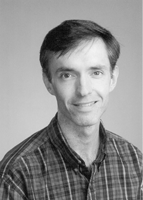Plays Well with Others
November 1, 2003

James Collins, a professor of biomedical engineering at Boston University, works in two seemingly disparate areas: gene regulation and human balance.
Two of this year's MacArthur Fellows---both collaboration-oriented individuals---work in (very different areas of) the mathematical sciences.
Barry A. Cipra
The current crop of MacArthur Fellows, announced October 5, includes two math-related recipients: James Collins of Boston University and Erik Demaine of MIT. Each will receive a "no-strings" grant of $500,000 over the next five years. Oddly, for an award that recognizes individuals, Collins and Demaine rarely publish solo papers. They are both best known for collaborative work.
Collins is a professor of biomedical engineering and co-director of BU's Center for BioDynamics (along with Nancy Kopell, who received a MacArthur in 1990). His current work encompasses two seemingly disparate subjects: gene regulation and human balance. Collins and colleagues Timothy Gardner and Charles Cantor have created a genetic "toggle switch" in the bacterium E. coli. The switch is an extremely simple network of mutually repressing genes. Under appropriate chemical or thermal conditions, the network flips between two stable states of gene expression---all neatly accounted for by a correspondingly simple system of equations. Genetically engineered switches should give insight into the more complicated networks controlling cellular processes. They may also have direct applications in gene therapies and biocomputing.
Collins's work on balance also has potential applications. He and co-authors Attila Priplata, James Niemi, Jason Harry, and Lewis Lipsitz have published a paper in The Lancet titled "Vibrating Insoles and Balance Control in Elderly People." The idea is based on the theory of stochastic resonance, which explains how a judicious amount of noise can actually enhance an otherwise undetectable signal. In the case of balance, pressure-sensitive nerves in the soles of the feet provide the brain with information that helps a person stay upright. If this signal is attenuated or the threshold for detecting it is elevated, as happens in the elderly and people with certain neuropathic conditions, postural sway (the minor movements you make when you are standing "still") increases---and along with it, the likelihood of falling. Collins and colleagues reported last year in Physical Review Letters that subjects exhibit less sway when standing on a vibrating pad. The Lancet paper describes a prototype insole that shows promise for reducing a major source of injury in the elderly.
Vibrating insoles are a few decades off for Demaine, who is 22 and has been a professor of computer science at MIT since 2001. Since 1998, he has published a steady stream of papers, most of them in computational geometry and data structures. Many have been written with his father, Martin Demaine, who home-schooled Erik and is currently a visiting scientist at MIT. Erik's Web site contains a list of more than a hundred other co-authors.
"He really likes to collaborate," says Joseph O'Rourke at Smith College, who is writing a book with Demaine. "He likes the social aspect of mathematics."
Demaine agrees. "It's faster and it's more fun," he says.
Fun is a key aspect of Demaine's work. He has solved problems in mathematical origami, the study of what can and cannot be done by folding and unfolding paper (see "Briefly Noted" for Philip Davis's short review of a new book from A.K. Peters on the mathematics of origami). In joint work with Susan Hohenberger and David Liben-Nowell, he has shown that the popular computer game Tetris, in which the object is to prevent a sequence of descending blocks from filling up a well, is NP-hard. He has also analyzed a class of rolling-coin problems, in which the object is to turn one geometric arrangement of touching coins into another. He even sees data structures as a game of sorts: In this case the game is to arrange data in a way that facilitates computation.

At 22, Erik Demaine, a professor of computer science at MIT, has written papers with more than a hundred co-authors, for the most part in computational geometry and data structures.
Demaine has not yet decided what to do with his MacArthur grant (neither has Collins), although "one thing it'll help me do is travel," he says. Another possible use could be the realization of a project he and his father have kicked around for some time, combining art and mathematics: a "shadow wall" consisting of a stationary arrangement of objects, such as bricks protruding from a wall, whose collective shadow would create an image that changes in a meaningful way during the course of a day---perhaps a man's face that would grow a true five o'clock shadow. (Another possibility would be an arrangement whose shadow looks random except on one day of the year.) The project appeals to Demaine because "it's a nice mix of open problems [in computational geometry] and art."
Barry A. Cipra is a mathematician and writer based in Northfield, Minnesota.

